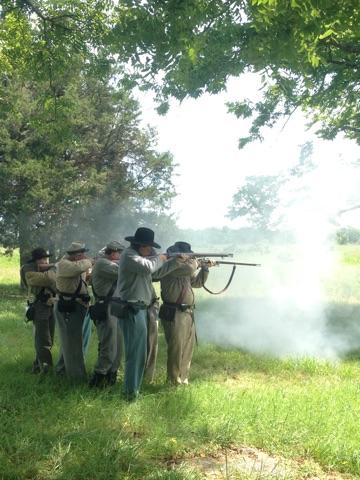Being a Civil War Intern: Living History Weekends
I often have daydreams of working on a Civil War battlefield. In my imagination, I am bedecked in the prestigious green and grey. In reality, things are a little different. While I did have the opportunity to participate in two living history events this summer, I found myself wearing a hot and itchy outfit consisting of wool pants, a wool coat, a hat, a plaid shirt, and braces (the Civil War version of suspenders).
In the first post of this series I discussed the giddy excitement of a new intern. It’s amazing how fast that excitement is replaced by apprehension when that same intern is told she will be one of the crew members participating in a public cannon demonstration. I’ll admit I did enjoy shooting the cannon, but it’s quite nerve wracking when the entire audience is waiting on you to make the boom!

photo cred: Claire Casey
Historical reenactment is not a new phenomenon. In fact, it began before the real fighting had even ended. Civil War veterans often recreated battles they themselves had participated in as a way to remember fallen comrades and to teach family and friends about the war. The popularity of reenactment grew in the United States during the 1980s and 1990s, with the 50th anniversary of the Battle of Gettysburg event in 1913 drawing nearly 50,000 Union and Confederate veterans.
By the time the 135th anniversary of Gettysburg rolled around in 1998, the event drew between 30,000-40,000 participants and 50,000 spectators. This is widely considered to be the largest reenactment the world has ever seen.
It’s important to note that the living history weekends at Stones River National Battlefield are not reenactments. The National Park Service banned historical reenactments from National Park property in 2006 because they felt that recreating the Civil War experience for today’s patrons to be an impossible task – not to mention the inevitable damage to the landscape such events cause.
While not reenactments, the living history weekends in which I participated this summer provided a fun and educational way for the public to learn about the Civil War. Fellow intern Shannon Rowe shared with me her thoughts about living history and what she hopes the public will gain from attending these programs:

photo cred: Claire Casey
I volunteered at Stones River for the living history programs. After spending about a year reenacting, I came to understand the importance of showing the public a snapshot into the life of a Civil War soldier. I certainly hoped to lead tours and work in the visitor center, but I ultimately wanted to spend my time in Civil War uniform. You can tell people about the battle and about what it must have been like for the common soldier all you want. It is hard to paint a picture with words, ones the visitors can really see, hear, smell, and feel. As a reenactor and a living historian, I hope that my impression as a soldier, whether as an infantryman or cannoneer, can help complete that picture.
Shannon went on to say that while living history programs and demonstrations do give visitors an idea of what the past was like, it’s important to realize that the experience is nothing like what a soldier actually went through during the 1860s.
I have never known what it feels like to put my life on the line, to wonder whether or not I would live to see tomorrow. I have never walked twenty miles a day for months on end in terrible footwear, on the edge of starvation. I do not believe that a living historian needs to go that far in order to give a visitor an accurate picture of the authentic soldier. Firing a single cannon or a few muskets can make a world of difference. Seeing the shocked expressions on visitors confirms this. I love to show them how long it actually takes to load and fire a rifle. Or how many people it takes to fire a cannon. I enjoy seeing their reactions when they hear the sound of a single cannon fire. So participating in living histories this summer at Stones River was very fulfilling because I knew that I was impacting the way that visitors view the Civil War, even if it was only in one small way.
Some people may wonder why anyone would volunteer to stand outside in the summer heat in a wool uniform – heck, there was a time even I would have dismissed the idea – but after having done it, I understand. While I don’t necessarily “enjoy,” standing outside in a wool uniform, I can say without a doubt that I love the idea of the public being interested in history on a more in depth level than simply reading a book or walking through a museum. As Shannon said, even a small demonstration can leave a lasting impact.
I believe it should be a personal goal for every historian to find a way to bridge the gap between the past and present for visitors, to make history tangible to the public. Being in constant contact with the public is one of my favorite parts of being an intern because I have the opportunity to help build that bridge. But it’s not easy – chances are, you aren’t going to make that connection with every visitor. But when you do, it’s an awesome feeling.
Ms Davis, Your blogs are extremely enjoyable, and you make me enthusiastic through your enthusiasm. I hope that I can meet you someday, as you continue your career as historian, ranger, author, lecturer.
Thank-you. I’m very happy to hear you enjoy reading the blog and that I help make you enthusiastic about Civil War history! One of my goals as a historian is to help people be more excited about our history and all that we can learn from it!